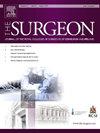Retrospective case series of vertebral artery injuries associated with cervical spine trauma
IF 2.3
4区 医学
Q2 SURGERY
Surgeon-Journal of the Royal Colleges of Surgeons of Edinburgh and Ireland
Pub Date : 2024-07-31
DOI:10.1016/j.surge.2024.07.007
引用次数: 0
Abstract
Background
Vertebral artery injuries (VAI) can occur due to cervical spine trauma. VAI can prove a serious complication and potentially compromise vascular supply to the posterior aspect of the brain. Currently, there is a paucity of evidence with regards to incidence, management, and outcomes for these patients. The purpose of this study is to investigate and elucidate the incidence of VAI associated with cervical trauma at a national tertiary referral centre for spinal pathology, their respective management, and associated outcomes.
Methods
A retrospective review was conducted from 2012 to 2021 to identify patients with VAI secondary to cervical spine trauma. Demographic, clinical, and radiological data was collected to identify common traits in injury characteristics and management.
Results
1013 spine patients presented to our institution across the 10-year period. 739/1013 (72.9 %) were trauma patients. 42/739 (5.7 %) were imaged for suspected VAI secondary to trauma. There were 14/739 (1.9 %) confirmed VAI. All patients had CT-angiography for diagnosis. Four of the confirmed VAI patients (28.6 %) had additional MR-angiography imaging. Right-side was the most common side of VAI injury (7/14; 50 %), followed by left (5/14; 35.7 %) and bilateral (2/14; 14.3 %) injuries. 8/14 (57.1 %) patients were prescribed anti-thrombotic therapy. Acute mortality within 3-months was noted to be 2/14 (14.3 %) and occurred at 49 days and 57 days respectively.
Conclusion
VAI associated with cervical spine injury is rare in occurrence. However, it can be associated with high morbidity and mortality. As such, a multi-disciplinary approach to care is integral to ensuring good outcomes in these patients.
与颈椎创伤相关的椎动脉损伤回顾性病例系列。
背景:颈椎创伤可导致椎动脉损伤(VAI)。椎动脉损伤是一种严重的并发症,有可能危及大脑后部的血管供应。目前,有关这类患者的发病率、管理和预后的证据还很少。本研究旨在调查和阐明一家国家级脊柱病理三级转诊中心与颈椎创伤相关的 VAI 发病率、各自的处理方法和相关结果:方法: 对 2012 年至 2021 年期间的病例进行回顾性分析,以确定因颈椎创伤而继发 VAI 的患者。我们收集了人口统计学、临床和放射学数据,以确定损伤特征和治疗的共同特点:结果:在这 10 年间,共有 1013 名脊柱患者到我院就诊。739/1013(72.9%)为外伤患者。42/739(5.7%)的患者因怀疑继发于外伤而接受了 VAI 检查。14/739(1.9%)人确诊为 VAI。所有患者都进行了 CT 血管造影诊断。在确诊的 VAI 患者中,有 4 人(28.6%)接受了额外的 MR 血管造影检查。右侧是最常见的 VAI 损伤侧(7/14;50%),其次是左侧(5/14;35.7%)和双侧(2/14;14.3%)。8/14(57.1%)名患者接受了抗血栓治疗。3个月内的急性死亡率为2/14(14.3%),分别发生在49天和57天:结论:与颈椎损伤相关的 VAI 很少发生。结论:与颈椎损伤相关的 VAI 发生率很低,但发病率和死亡率却很高。因此,多学科的护理方法是确保这些患者获得良好疗效不可或缺的因素。
本文章由计算机程序翻译,如有差异,请以英文原文为准。
求助全文
约1分钟内获得全文
求助全文
来源期刊
CiteScore
4.40
自引率
0.00%
发文量
158
审稿时长
6-12 weeks
期刊介绍:
Since its establishment in 2003, The Surgeon has established itself as one of the leading multidisciplinary surgical titles, both in print and online. The Surgeon is published for the worldwide surgical and dental communities. The goal of the Journal is to achieve wider national and international recognition, through a commitment to excellence in original research. In addition, both Colleges see the Journal as an important educational service, and consequently there is a particular focus on post-graduate development. Much of our educational role will continue to be achieved through publishing expanded review articles by leaders in their field.
Articles in related areas to surgery and dentistry, such as healthcare management and education, are also welcomed. We aim to educate, entertain, give insight into new surgical techniques and technology, and provide a forum for debate and discussion.

 求助内容:
求助内容: 应助结果提醒方式:
应助结果提醒方式:


